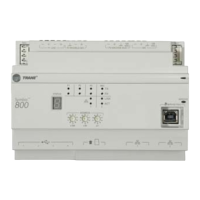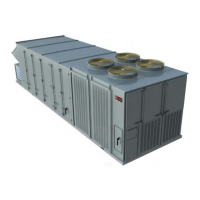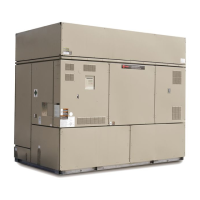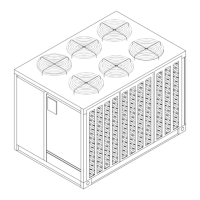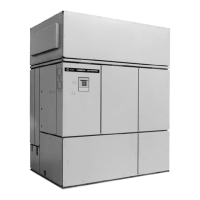80
RT-SVX24Q-EN
Field Installed Control Wiring
The Rooftop Module (RTM) must have a mode input in
order to operate the rooftop unit. The flexibility of
having several system modes depends upon the type
of sensor and/or remote panel selected to interface
with the RTM. An overall layout of the various control
options available, with the required number of
conductors for each device, is illustrated beginning
with Figure 59, p. 86.
NNoottee:: All field wiring must conform to NEC guidelines
as well as state and local codes.
WWAARRNNIINNGG
HHaazzaarrddoouuss VVoollttaaggee!!
FFaaiilluurree ttoo ddiissccoonnnneecctt ppoowweerr bbeeffoorree sseerrvviicciinngg ccoouulldd
rreessuulltt iinn ddeeaatthh oorr sseerriioouuss iinnjjuurryy..
DDiissccoonnnneecctt aallll eelleeccttrriicc ppoowweerr,, iinncclluuddiinngg rreemmoottee
ddiissccoonnnneeccttss bbeeffoorree sseerrvviicciinngg.. FFoollllooww pprrooppeerr
lloocckkoouutt//ttaaggoouutt pprroocceedduurreess ttoo eennssuurree tthhee ppoowweerr
ccaann nnoott bbee iinnaaddvveerrtteennttllyy eenneerrggiizzeedd.. VVeerriiffyy tthhaatt nnoo
ppoowweerr iiss pprreesseenntt wwiitthh aa vvoollttmmeetteerr..
WWAARRNNIINNGG
PPrrooppeerr FFiieelldd WWiirriinngg aanndd GGrroouunnddiinngg
RReeqquuiirreedd!!
FFaaiilluurree ttoo ffoollllooww ccooddee ccoouulldd rreessuulltt iinn ddeeaatthh oorr
sseerriioouuss iinnjjuurryy..
AAllll ffiieelldd wwiirriinngg MMUUSSTT bbee ppeerrffoorrmmeedd bbyy qquuaalliiffiieedd
ppeerrssoonnnneell.. IImmpprrooppeerrllyy iinnssttaalllleedd aanndd ggrroouunnddeedd
ffiieelldd wwiirriinngg ppoosseess FFIIRREE aanndd EELLEECCTTRROOCCUUTTIIOONN
hhaazzaarrddss.. TToo aavvooiidd tthheessee hhaazzaarrddss,, yyoouu MMUUSSTT ffoollllooww
rreeqquuiirreemmeennttss ffoorr ffiieelldd wwiirriinngg iinnssttaallllaattiioonn aanndd
ggrroouunnddiinngg aass ddeessccrriibbeedd iinn NNEECC aanndd yyoouurr llooccaall//
ssttaattee//nnaattiioonnaall eelleeccttrriiccaall ccooddeess..
The various field installed control panels, sensors,
switches, and contacts discussed in this section require
both AC and DC consideration. These diagrams are
representative of standard applications and are
provided for general reference only. Always refer to the
wiring diagram that shipped with the unit for specific
electrical schematic and connection information.
Controls using 24 VAC
Before installing any connecting wiring, refer to Figure
16, p. 39 for the electrical access locations provided on
the unit, and Table 41, p. 80 for AC conductor sizing
guidelines. Then check the following:
NNOOTTIICCEE
UUssee CCooppppeerr CCoonndduuccttoorrss OOnnllyy!!
FFaaiilluurree ttoo uussee ccooppppeerr ccoonndduuccttoorrss ccoouulldd rreessuulltt iinn
eeqquuiippmmeenntt ddaammaaggee aass tthhee eeqquuiippmmeenntt wwaass nnoott
ddeessiiggnneedd oorr qquuaalliiffiieedd ttoo aacccceepptt ootthheerr ttyyppeess ooff
ccoonndduuccttoorrss..
1. Use copper conductors unless otherwise specified.
2. Ensure that the AC control wiring between the
controls and the unit's termination point does not
exceed three (3) ohms/conductor for the length of
the run.
NNoottee:: Resistance in excess of 3 ohms per conductor
may cause component failure due to insufficient
AC voltage supply.
3. Make sure to check all loads and conductors for
grounds, shorts, and mis-wiring.
Table 41. AC conductors
Distance from Unit to
Control
Recommended Wire
Size
000-460 feet
18 gauge
461-732 feet
16 gauge
733-1000 feet
14 gauge
4. Do not run the AC low voltage wiring in the same
conduit with the high voltage power wiring.
Controls using DC Analog Input/Outputs
Before installing any connecting wiring between the
unit and components utilizing a DC analog input\output
signal, refer to the appropriate illustration in Figure 16,
p. 39 for the electrical access locations provided on the
unit and Table 42, p. 80 for conductor sizing guidelines.
Then check the following:
NNOOTTIICCEE
UUssee CCooppppeerr CCoonndduuccttoorrss OOnnllyy!!
FFaaiilluurree ttoo uussee ccooppppeerr ccoonndduuccttoorrss ccoouulldd rreessuulltt iinn
eeqquuiippmmeenntt ddaammaaggee aass tthhee eeqquuiippmmeenntt wwaass nnoott
ddeessiiggnneedd oorr qquuaalliiffiieedd ttoo aacccceepptt ootthheerr ttyyppeess ooff
ccoonndduuccttoorrss..
1. Use standard copper conductor thermostat wire
unless otherwise specified.
2. Ensure that the wiring between the controls and the
unit termination point does not exceed two and a
half (2.5) ohms/conductor for the length of the run.
NNoottee:: Resistance in excess of 2.5 ohms per conductor
can cause deviations in the accuracy of the
controls.
Table 42. DC conductors
Distance from Unit to
Control
Recommended Wire
Size
000-150 feet
22 gauge
151- 240 feet
20 gauge
241- 385 feet
18 gauge
IInnssttaallllaattiioonn
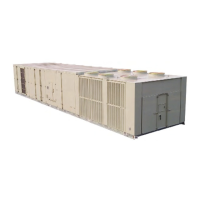
